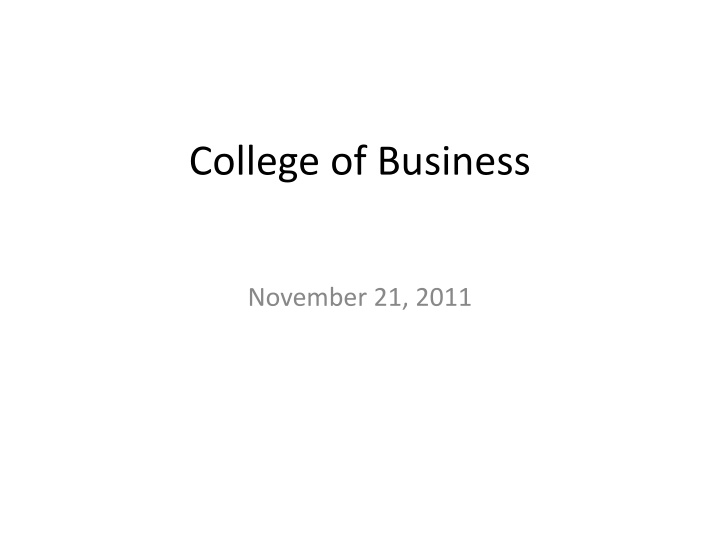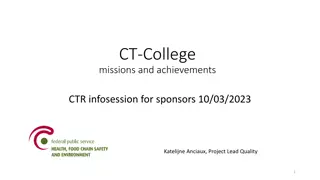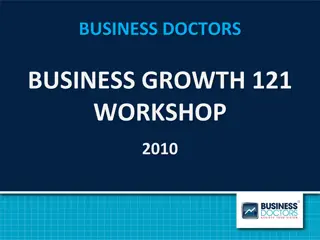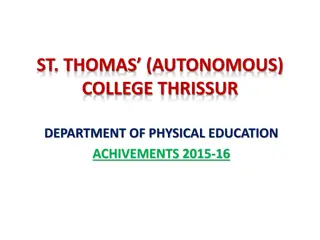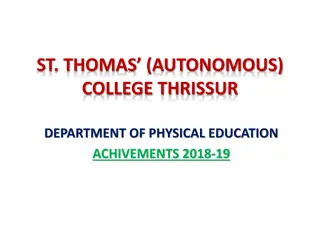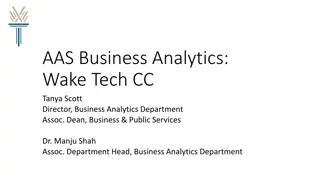Comprehensive Overview of College of Business
This comprehensive overview provides detailed information about the College of Business, including enrollment statistics, faculty composition, degrees awarded, departmental structure, and strategic growth plans. It covers various aspects such as MBA enrollment trends, Computer Information Systems data, and fall 2011 faculty information. The data is presented visually through images for easy understanding.
Download Presentation

Please find below an Image/Link to download the presentation.
The content on the website is provided AS IS for your information and personal use only. It may not be sold, licensed, or shared on other websites without obtaining consent from the author.If you encounter any issues during the download, it is possible that the publisher has removed the file from their server.
You are allowed to download the files provided on this website for personal or commercial use, subject to the condition that they are used lawfully. All files are the property of their respective owners.
The content on the website is provided AS IS for your information and personal use only. It may not be sold, licensed, or shared on other websites without obtaining consent from the author.
E N D
Presentation Transcript
College of Business November 21, 2011
Departmental Structure At the present time, no separate departments Previous departmental structure Management, Marketing, and Computer Information Systems Accounting and Finance Office Systems and Business Education
Enrollment (803) Bachelor Accounting (161) Computer Information Systems (42) Entrepreneurship (61) Finance (74) Management (151) Marketing (99) Ski Area Management (8) Associate Computer Information Systems (22) General Business (29) Health Information Processing (41) Office Information Assistant (12) Certificate Office Services (3) - Undeclared, etc. (65) MBA (35) plus ? 8 in winter
Faculty Composition 17 tenured Accounting (4) CIS (2) Entrepreneurship (1) Finance (2) Management (6) Marketing (2) 4 continuing contract Associate Degrees (2) CIS (2) Term Accounting (1) 2yr Business Law (1) 2yr Marketing (1) Taxation/Accounting (1)- 3yr 4 tenure track CIS (1) Entrepreneurship (1) Finance (1) Marketing (1)
MBA 40 35 30 25 20 MBA enrollment 15 10 5 0 2005 2006 2007 2008 2009 2010 2011 2012 2013
Computer Information Systems 120 100 80 BCIS enrollment (4yr) CIS enrollment (2yr) 60 BCIS degrees (4yr) CIS degrees (2yr) 40 20 0 2005 2006 2007 2008 2009 2010 2011 2012 2013
Degrees Awarded 1200 1000 800 CoB enrollment 600 CoB degrees 400 200 0 2005 2006 2007 2008 2009 2010 2011 2012 2013
Fall 2011 Faculty Data ACT CIS ENTR MGT FIN MKT # Faculty (FTE) 6 (6.41) 5 (4.17) 2 (2) 8 (8.33) 3 (3.08) 4 (4) # Course Total Credit Hours 16 19 29 9 14 64 48 116 36 56 SCH Majors 2126 1374 656 1993 785 1552 161 42 (4yr) 22 (2yr) 61 151 74 99 SCH per FTE 286.9 265.8 328 332.2 254.9 310.4 4 year Majors per faculty 26.8 8.4 30.5 18.9 24.7 24.8
Strategic Growth - MBA MBA enhancement One tenure-track faculty line to cover MBA expansion Area of expertise International Business & Health Care Administration
Strategic Growth - MBA NMU Road Map Innovation Goal Goal: An academic curriculum that balances successful programs with new offerings at the undergraduate and graduate level to meet the needs of students, as well as improve student career opportunities A1. Integrate global engagement and diversity learning experiences throughout the academic curriculum. A4. Explore and act upon opportunities to expand programs in nursing and allied health to meet the growing demand for professionals in health care and related fields. A5. Explore and act upon graduate programming (certificate, master s doctoral) in areas of recognized strengths, needs, and opportunities
International Business Integrate global and diversity learning experiences into the business curriculum (A1) Respond to increasing competition from peer business schools (LSSU-establishing int l business major; MTU-strong int l business emphasis in curriculum) Improve the level of preparation of our graduates Increase partnerships with programs outside the U.S.
Health Care Administration Marquette County is the health care hub of the U.P. Meets the growing demand for professionals in health care and related fields (A4) Government Bureau of Labor Statistics: Master s in health care administration is the standard credential for the field Projected that health care administration will grow 16% by 2018
The business of the health industry is approximately 17% of the US GDP (OECD Health Data 2009). This is up from 13.6% in 2000. A steady increase for the future is undeniable. There is a need for business professionals to lead and manage the industries supporting and involved in the health industry.
